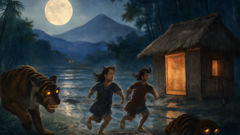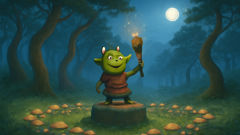Introduction
Before the stones of the oldest temples were smoothed by pilgrims’ palms and long before maps named rivers and forests, storytellers spoke of two ancient families: the winged Garuda, a being of sunlight and thunder, and the Nagas, serpentine keepers of waters, earth, and secret things. They were not merely monsters or beasts to frighten children; they embodied the tensions of life itself — sky and soil, flight and depth, hunger and guarding. Across the subcontinent and beyond into the islands and kingdoms of Southeast Asia, their story traveled, adapted, and nested within local beliefs until it became both myth and mirror. In some versions the first quarrel began with a debt, in others with a promise broken, and in others still with a cosmic misunderstanding. Temples carved with coiling serpents and soaring birds show the same drama frozen in stone: talons and fangs, beaks and crowns, an ageless enmity that also gave rise to protection rituals, royal emblems, and folk dances. This retelling gathers those fragments — the Vedic echoes, the village tales, the temple reliefs — to explore why the Garuda and the Naga continued to haunt and comfort human imagination. We follow the myth from its origins to its many faces: as a lesson about balance, as a symbol of sovereignty, and as a living thread in festivals and songs. Along the way there will be scenes of battle and scenes of unlikely compassion, descriptions of carved friezes glinting in dusk, and an examination of how communities used the story to name dangers and devise safeguards. The tale is ancient but not static; its edges have been softened, sharpened, and painted anew by each storyteller. Read on to meet the bird that flies toward the sun and the serpent that keeps the deep, and to see how their eternal conflict taught people to read the world around them.
Origins and the Sky-Deep Conflict
The story of Garuda and the Nagas begins in a mythic geography where sky and water meet every morning and night. In the earliest layers of the tradition, accessible through Vedic fragments and later Puranic retellings, Garuda is born from a godly lineage, a creature whose breath smells of ozone and whose wings bring storms. He is the mount, or vahana, of Vishnu in many tellings, though earlier references portray him as a powerful being with his own agency: a sovereign of the air who hunts that which hides beneath. The Nagas, by contrast, descend from the earth and water: they are semi-divine serpents who dwell in subterranean realms, in riverbeds, lakes, and the haunted hollows of mountains. Nagas are guardians of treasure, of springs, and sometimes of fertility and rain. Their heads are often crowned; their bodies are sometimes given many coils or multiple heads; their world is deep and slow.

Long before kings adopted the motifs as emblems, the myth framed a natural antagonism. Garuda rules the wide openness of sky where sudden hunger can strike; the Naga rules the narrow secrets of the dark where hoarded wealth and the sources of life are kept. One common origin story tells of a dire need: the mother of Garuda is enslaved by the serpents, compelled to serve them, and her son vows freedom. In that telling, the Nagas had been given a life-affirming boon — protection of their children — and had misused it, creating a situation that demands correction. Another narrative thread casts the quarrel as a cosmic bargain gone wrong: the Nagas once held a nectar or jewel that could grant immortality. The Garuda, or his kin, needed that nectar to free themselves or to settle debts owed to the gods. When negotiations turned to theft and pursuit, the first great clash occurred. In some poems the first combat is almost ritualized: Garuda swoops and the Nagas coil, each move measured, each strike a law of nature. The result is not simply victory but an agreement: Garuda will take certain rights and the Nagas will be promised protection under specific constraints. This is why many stories end with a codified truce: garlands of protections, charms, or the knowledge that Garuda may eat the Nagas' enemies but not the Nagas themselves unless certain prohibitions are violated.
These origin variations tell us something about the societies that told them. A people who depend on both rain and flight — fishermen, rice farmers, traders who travel by river and by sky — need narratives that account for the fragile reciprocity of nature. The Garuda/Naga myth is therefore partly ecological metaphor. The bird can be the heat that dries the paddy; the serpent the water that keeps it alive. Their fights are storms and floods, their truces are seasons. And because the Nagas are guardians of hidden wealth — jewels, knowledge, springs — the myth also explores human anxieties about hoarding and sharing. Temple inscriptions and carvings, especially from the early medieval period, dramatize these tensions. A stone panel from a southern temple might show a proud Garuda clutching a serpent, while an eastern relief from Bengal emphasizes the Naga's royalty with multiple hoods flaring like a canopy. These regional emphases reflect local economies and climates, as well as political needs: kings linked themselves to Garuda to claim the aerial dominance of trade and power, while rulers close to riverine plains invoked Naga imagery to assert control over water and fertility.
The descriptive richness of these tellings is matched by ritual practice. In many agrarian communities, rites meant to placate the Nagas accompany seasonal irrigation; offerings are made at riverbanks to ensure the serpent-guardians will not withdraw their waters. Conversely, offerings to Garuda or images of him mounted high on poles appear during drought to call the swift winds or to ward off pestilence. Folktales add moral complexity: a Garuda who devours indiscriminately is a cautionary figure, and a Naga who hoards beyond necessity invites ruin. Thus the myth becomes a framework for balancing courage and restraint, hunger and stewardship.
But the conflict is also cosmic. In larger Hindu cosmology, Garuda’s association with Vishnu gives him a role in preserving dharma, the order of things. Nagas, sometimes allied with Shiva or local deities, are ambiguous: both dangerous and sacred. When those ties are mapped onto human affairs, the Garuda becomes a symbol of righteous force — swift, visible, and sometimes imperial — while the Naga embodies the subterranean pulse of cultures: lineage memory, ancestral power, and the unpredictable generosity of nature when it chooses. Scholars who trace iconographic shifts across centuries see how the bird and serpent motifs traveled across islands and kingdoms with merchants, pilgrims, and artists. As these motifs traveled, they acquired new attributes: in Java Garuda might gain a more avian-human posture, while nagas took on new local colors and functions.
Stories of their encounters vary in tone. Some are outright battles — dramatic skies torn by wings and water churned by coils. Others are intricate negotiations where promises bind the two families with laws and taboos. There are tales of trickery that hinge upon language and cleverness: a serpent who boots out a rival by riddles and a bird who rescues his kin through a daring bluff. There are also quieter legends — a Garuda who shelters a Naga child during a storm, or a Naga who helps an old man find a lost spring because the man sang a hymn long forgotten. Those compassionate refrains complicate the neatness of enmity and suggest that the myth allows for reconciliation. That possibility is essential because these images live not only in myth but in daily life: in houses that hang talismans of Garuda to ward off snakebites, in fishermen who whisper to the depths in homage to the Nagas, in kings who carve both bird and serpent to show they can command sky and water.
In narrative terms, the Garuda and the Naga are heroes and antiheroes in alternation. Their episodes function like parables: a king who trusted only his Garuda amulet and ignored the river’s risks met ruin when waters rose; a village that bribed a Naga spirit but refused to share its harvest suffered a pestilence that no charm could touch. Thus the myth teaches practical ethics about reciprocity. It also fosters a cultural language of protection and danger: to speak of a "Naga-house" evokes deep secrecy and hidden danger, while a "Garuda-standard" suggests visible authority and protective force. These metaphors remained powerful enough that foreign travelers, hearing them, sometimes recorded generalized impressions: winged figures on temple eaves, serpents braided into palace columns, dancers enacting battles in seasonal festivals. Modern historians find in those travelers’ accounts hints of how myth and politics braided together, with rulers using the myth to justify raids, alliances, or marriages. The myth was never merely an aesthetic ornament; it always had teeth.
Art preserved the conflict in its most public form. Bas-reliefs freeze the dramatic moment when beak meets hood; bronze sculptures capture the tension in mid-flight; painted scrolls narrate entire sagas in panels. The artistic vocabulary grew vast: feathers became flames, scales turned into leaves, and both bird and serpent could wear crowns. Devotional songs layered emotive resonance over narrative structure, while itinerant storytellers embroidered the tales with local characters, gods, and jokes. Folk theater turned battle into choreography; shadow-puppetry made the fight smaller and somehow more intimate, projected onto a lit screen in a village courtyard. As the story dispersed across regions, it accommodated political agendas and spiritual needs while retaining core dynamics: the aerial power of Garuda versus the subterranean sovereignty of the Naga.
This layered origin — mythic, ecological, social, and political — explains the legend's endurance. It answers why, even now, a carved Garuda above a temple gate or a painted Naga on a bridge can be read both as art and as instruction. The story endures because it helps people navigate their world: the weather, the seasons, rulers’ claims, and the moral economy of sharing. The tension between sky and depth, displayed with such vivid imagery, continues to shape ritual acts, symbol systems, and narratives of identity. Yet, for all its ancient weight, the myth is not solemn alone; it includes humor and irony: a Nagas' sly joke, a Garuda's embarrassed retreat, a human who outwits both. That elasticity — the ability to be fierce and comic, sacred and ordinary — is the reason the story kept moving, always ready to be told again.
Tales, Temples, and Living Traditions
If the first section traced the mythic genesis, this one follows the legend outward into people's lives: temple carvings, courtly emblems, village rituals, and the everyday talismans that keep the story living. Across India and into Southeast Asia, the Garuda and the Naga appear in countless media. In the grand temples of Angkor and Borobudur the motifs are adapted into local cosmologies: Nagas become bridges between worlds, their undulating bodies functioning as literal and symbolic connectors; Garudas become national emblems or protective spirits. Closer to home in the subcontinent, riverbank shrines celebrate the serpent-guardians with offerings of milk and flowers; on certain nights, villagers gather to chant and to pour water as tribute. In more urban contexts, kings and nobles adopted the Garuda as an insignia of sovereignty, visually asserting their right to govern both sky-born travelers and river-borne merchants.

Artistic depictions are not mere illustration; they are claims. When a palace gate features a gilded Garuda, the message is political and spiritual: I protect, I assert order. When a temple's inner sanctum is flanked by carved Nagas, the declaration differs: we guard the source of life — springs, lineage, hidden wealth. In many rituals these motifs converge. Consider the festival of the monsoon-edge villages where the community's survival depends on irrigation. First comes a procession: the Garuda-image is carried high on a pole, shining in the sun, its eyes painted fierce to frighten away pestilence; then elders turn to the river to propitiate the Naga beneath. They chant the songs that have been passed down, and offerings — betel, coins, rice — are placed at the water's edge. Here the myth functions as a negotiated ritual: the people ask both sky and depth to keep their promises.
The narrative variations produce local flavors. In Kerala, there are ballads that depict the Naga as ancestral house spirits, beneficent if respected, vengeful if offended. Houses built on old Naga-mounds often carry shrine spaces where offerings are daily. In Odisha, coastal communities tell of Garuda stealing the pearl of a Naga queen, provoking storms and costly reparations that teach children the perils of greed. Among the Javanese retellings, Garuda becomes almost human in his sorrow and pride; he seeks a mate, faces betrayal, and learns the limits of power. Each region, by absorbing the myth, made it speak to local anxieties: about water management, about foreign threats, about succession, and about environmental change.
The story's performance forms — dance, shadow-puppet theater, and ritual drama — allow communities to rehearse social lessons. A dancer, arms outstretched, becomes the Garuda in a village square, while an actor in a long, fringed costume slithers as Naga. The choreography transforms cosmic conflict into community spectacle, letting audiences laugh at a clumsy bird or gasp at a snake's cunning. Such performances are moral training: they show the rewards of humility, the costs of arrogance, and the ways ordinary people can mediate between forces greater than themselves. The actors, like the carved stones, keep narrative memory in motion.
Modern adaptations continue the process. Poets and novelists riff on the ages-old clash, placing it in contemporary settings — a corporation that treats rivers as resources becomes the modern Naga, or a vigilante force acting like a Garuda. Filmmakers stage mythic sequences with CGI wings and digitally coiled serpents, but even as spectacle grows more technological the core metaphors remain accessible: flight and depth, exposure and secrecy, hunger and guardianship. That accessibility explains why multinational emblems still reference Garuda — the image conveys swift protection — while local craftspeople still braid Naga motifs into temple railings and doorframes.
The myth has also influenced ways communities cope with ecological crisis. When rivers dry or wells sink, elders invoke Naga tales to teach younger generations about respect for water sources. Conservationists sometimes use mythic language to foster stewardship, suggesting that treating a river as if a living Naga stands to honor it, reducing wasteful practices. Conversely, when skies darken with pollution, campaigners invoke Garuda imagery to urge swifter, aerial-scale interventions: policy, research, and technological fixes. Thus, the myth becomes a rhetorical bridge connecting heritage and modern responsibility.
There are, too, moments of remarkable tenderness within the tradition. One tale tells of an orphaned village child who discovers a small Naga trapped under a fallen banyan root. The child sings lullabies, feeds the creature curds, and in return the Naga reveals a hidden spring. The child’s modest generosity revives the fields. Another story speaks of a feather-lost Garuda who lands among fishermen and learns to share their meager catch; the bird's humility transforms into a legend of coexistence. These softer narratives remind listeners that the myth is not only about conflict but also about mutual recognition. The mightiest beings can be taught compassion by the smallest humans; the fiercest guardians can be softened by acts of everyday kindness.
Material culture preserves these compassion scenes in surprising places. A 12th-century votive plaque from a river temple depicts a kneeling woman placing an offering at the tail of a sleeping Naga. Nearby, a painted scroll shows a Garuda bowing to a child. Such images complicate the facile reading of the myth as purely violent. They suggest that human agency mediates divine disputes.
Pilgrimage rituals underscore how the myth integrates social continuity and memory. Pilgrims travel to shrines that are geographically strategic — confluences of rivers, springs at the foot of mountains, high places where winds are strong — because these intersections are where legends say Garuda and Naga meet. At such sites, stones and images form palimpsests: earlier symbols are repainted, older icons incorporated into newer buildings. As a result, these shrines become living archives of changing belief systems. A festival might gather hundreds who bring rice, cloth, and incense; the offerings are shared, eaten, and returned to the community, creating a cycle of reciprocity that mirrors the myth itself.
The legend also functions in law and diplomacy in surprising ways. Rulers historically crafted treaties invoking naga guardianship or garuda protection as metaphors to affirm alliances or territory control. Colonial administrators recorded these practices, sometimes misunderstanding them, sometimes co-opting the imagery for their own symbols. Post-independence states reclaimed the motifs: Garuda became a national emblem in some places; Naga identities became political markers in others, with ethnic groups adopting Naga symbolism to assert heritage. These modern political uses show how malleable the legend is — always available for redefinition.
Finally, we find the myth enshrined in everyday objects: amulets shaped like stylized birds, brass bells carved with scales, door lintels where a tiny Garuda glares outward. Parents tuck small talismans under children's pillows and whisper fragments of the story to steady them through storms. The narrative thus continues in private and public, in stone and in song, in national emblems and neighborhood shrines. It remains a reservoir of images that people draw from to interpret weather, power, and morality. The Garuda and the Naga are not prehistoric relics; they are living metaphors that help people talk about the forces that shape their lives. Their conflict is both a drama and a lesson, a way to hold complexity in a single image: a bird beating wings above a coiling serpent, both necessary, both dangerous, both capable of great protection and terrible harm.
Through these many faces — theatrical, political, ritual, and domestic — the legend endures. It teaches communities to respect hidden sources, to understand visible might, and to remember that survival often depends on negotiating between the sky's hunger and the earth's discretion. Above all, it offers a poetic grammar for a world in which extremes meet and must learn to live with one another.
Conclusion
The tale of the Garuda and the Naga persists because it answers an old human need for images that reconcile opposites. It gives shape to the unwieldy forces that govern weather, wealth, safety, and danger; it offers rituals for communities to negotiate those forces; and it supplies metaphors to make sense of political authority and ecological stewardship. As stone and song, as dance and amulet, the myth teaches restraint and audacity in equal measure: do not hoard what keeps the village alive, and do not fly so high as to forget the river that gives your food. Its endurance also reflects the story's generosity; the legend allows compassion within conflict, showing that enemies can be allies and that ancestors in coiled silence sometimes protect us more than the loudest guardian from the sky. In contemporary times, as climate challenges and social transformations render ancient lessons urgent in new ways, the Garuda and the Naga offer a cultural language for negotiation — a reminder that balance often requires imagination, ceremony, and humble action. When you see their images carved above a doorway or painted on a festival float, you are witnessing more than art: you are looking at a living narrative, a conversation between sky and deep that has guided people for generations and still teaches us how to live with forces greater than ourselves.













